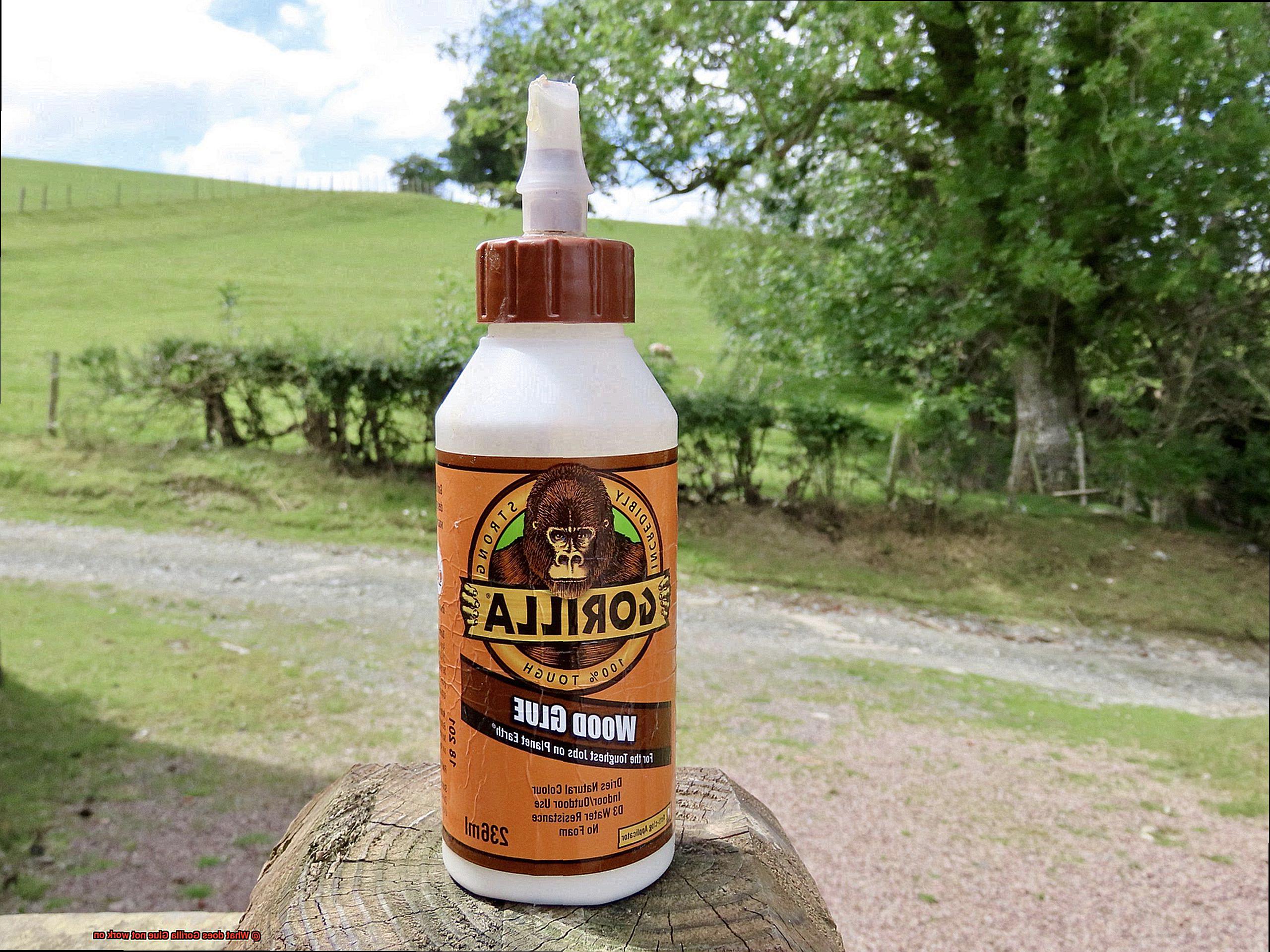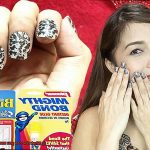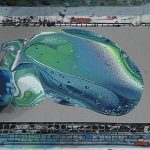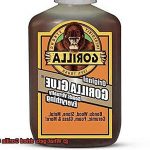Tired of wimpy glues that can’t hold their own? Well, say hello to Gorilla Glue, the superhero adhesive.
This stuff is strong and versatile, making it a go-to for all your home improvement projects. But here’s the thing: even the mighty Gorilla Glue has its kryptonite.
So grab your tool belt and let’s explore where this adhesive falls short.
What is Gorilla Glue?
Contents
Look no further than Gorilla Glue. Renowned for its remarkable bonding strength and versatility, Gorilla Glue has become a staple for DIY enthusiasts and professionals alike. This comprehensive article will explore the capabilities of Gorilla Glue, its various forms, and crucial considerations when utilizing it.
The Power of Polyurethane:
At the core of Gorilla Glue rests its secret weapon: polyurethane resin. This component empowers Gorilla Glue to form an incredibly robust bond. When exposed to moisture, the resin reacts and expands, effectively filling gaps and creating an airtight seal. This unique expansion feature makes Gorilla Glue ideal for securing uneven or rough surfaces.
Forms for Every Project:
Gorilla Glue offers a range of forms to cater to diverse needs. The liquid form is the epitome of versatility, capable of bonding materials such as wood, metal, stone, ceramic, leather, and more. For vertical surfaces or meticulous applications, the gel form provides enhanced control. Meanwhile, the tape form proves invaluable for swift fixes or smooth surfaces like glass or plastic. Regardless of your project’s demands, Gorilla Glue has a solution.
Resistance to Water and Extreme Temperatures:
Among Gorilla Glue’s standout features is its exceptional resistance to water and extreme temperatures. Once cured, it remains impervious to both scorching heat and freezing cold, rendering it suitable for indoor and outdoor projects alike. However, it is important to acknowledge that prolonged exposure to water can gradually weaken the bond over time. For continuous water contact or underwater applications, a specialized waterproof adhesive is recommended.
Limitations to Consider:
While Gorilla Glue reigns supreme as a powerhouse adhesive, it does possess limitations. It struggles with bonding non-porous materials like glass, metal, and certain plastics. Moreover, it may not be suitable for flexible materials requiring frequent movement, and it lacks certification as food-safe. It is crucial to conduct a small-scale test of Gorilla Glue before committing to larger applications.
What Surfaces Does Gorilla Glue Not Work On?
Gorilla Glue, the superhero of adhesives, has earned a reputation for its unparalleled strength and versatility. However, even superheroes have their kryptonite. In this article, we will venture into the uncharted territories of surfaces that may challenge Gorilla Glue’s bonding abilities. By examining factors such as texture, composition, and chemical properties, we will uncover the surfaces where Gorilla Glue may not achieve its full potential. Prepare to embark on a journey through the triumphs and limitations of this mighty adhesive.
Porous Surfaces:
Gorilla Glue thrives on bonding porous materials like wood and fabric, but it may stumble when faced with foam, rubber, or certain plastics. The limited surface area for the glue to grip onto can result in a weaker bond. To overcome this hurdle, consider using adhesives specifically designed for these materials or roughen up the surface with sandpaper to enhance adhesion.
Smooth Operators:
Smooth surfaces such as glass or certain metals can prove to be formidable adversaries for Gorilla Glue. Without enough texture to cling onto, the glue may struggle to form a strong bond. Fear not. Victory can still be achieved by employing specialized adhesives or by roughening these surfaces before applying Gorilla Glue.
Wet and Wild:
If your project involves surfaces that are constantly exposed to moisture or water, Gorilla Glue may not be your trusty sidekick. Moisture can interfere with the glue’s setting process and weaken the bond over time. To ensure a watertight seal, opt for a waterproof adhesive specifically formulated for wet conditions.
The Contaminant Conundrum:
Certain oils or chemicals present on surfaces can disrupt Gorilla Glue’s adhesive properties. It is crucial to ensure that the surface is clean and free from any contaminants before applying the glue. A quick wipe-down with rubbing alcohol or a suitable cleaner should eliminate these obstacles.
Specialized Solutions:
Gorilla Glue offers a range of specialized products tailored to different applications, such as wood glue, super glue, and epoxy. Utilizing these variants ensures optimal performance on specific surfaces and materials. Before embarking on your project, check if there is a Gorilla Glue variant designed precisely for your needs.
Non-Porous Surfaces
Non-porous surfaces, such as glass, metal, plastic, ceramic, and certain wood finishes, present unique challenges when it comes to achieving a solid bond. As sleek and smooth as they may appear, these materials do not readily absorb fluids or air, making it difficult for adhesives to penetrate and form a strong connection. This is where Gorilla Glue encounters its toughest test.
The primary issue with using Gorilla Glue on non-porous surfaces lies in its reliance on moisture to activate its bonding properties. These smooth surfaces do not readily soak up water like a sponge, which can hinder the glue from fully curing or securely bonding.
There are techniques to overcome this obstacle and achieve successful adhesion. One effective method is to roughen up the surface before applying the glue. By lightly sanding the material, you create a better grip for the adhesive, allowing it to adhere more effectively. Another trick is to introduce moisture by dampening the surface slightly. This helps activate the glue and improve adhesion.
However, it’s important to note that while Gorilla Glue may not be the ultimate solution for non-porous surfaces, the brand offers other products specifically designed for these materials. Gorilla Super Glue Gel and Gorilla Epoxy are two examples of specialized adhesives that excel in bonding non-porous surfaces.
In some cases, relying solely on glue may not provide enough support. Using mechanical fasteners like screws or clamps in conjunction with Gorilla Glue can provide extra reinforcement and ensure a more secure bond on non-porous surfaces.
Before embarking on your gluing project, it’s always wise to conduct a small test on an inconspicuous area. This allows you to assess the adhesive’s performance before committing to your masterpiece.
If Gorilla Glue doesn’t meet your needs for a non-porous surface project, don’t despair. There are alternative adhesives available that are specifically designed for these materials. Conduct thorough research to find the perfect match for your bonding requirements.
Polyethylene and Polypropylene Plastics
In this article, we will explore the intricate molecular structure of these plastics and uncover the key differences that make bonding a challenge. We will also discuss specialized adhesives that are specifically formulated to conquer this sticky situation.
The Molecular Makeup
Polyethylene and polypropylene plastics are renowned for their durability, flexibility, and cost-effectiveness. However, their smooth surfaces pose a unique challenge when it comes to bonding. These plastics are composed of non-polar carbon-hydrogen bonds, which render their surfaces non-reactive to many adhesives, including Gorilla Glue.

Polar vs. Non-Polar
Gorilla Glue is engineered to bond with polar surfaces found in wood or metal. These surfaces possess more reactive chemical groups that facilitate bonding. However, when applied to polyethylene or polypropylene plastics, Gorilla Glue struggles to form a robust bond due to the lack of chemical interaction. The non-polar nature of these plastics inhibits the adhesive from establishing a firm connection.
Specialized Solutions
Fortunately, there are specialized adhesives available in the market that are explicitly designed for bonding polyethylene and polypropylene plastics. These adhesives incorporate chemical additives that enhance their bonding capabilities with these low surface energy plastics. By introducing specific compounds into the adhesive formula, these specialized products overcome the challenges posed by the non-polar nature of the plastics.
In our quest for understanding the disparities between polyethylene and polypropylene plastics, it becomes evident why Gorilla Glue may not be the ideal choice for bonding. The molecular structure of these plastics renders their surfaces non-reactive to many adhesives, including Gorilla Glue.
However, specialized adhesives tailored for bonding these plastics offer a solution by incorporating chemical additives that enhance bonding capabilities.
Flexible Materials
Perhaps you’ve heard about the legendary strength of Gorilla Glue and are considering it as your adhesive of choice. However, before you dive headfirst into the adhesive world, let’s explore why Gorilla Glue may not be the best fit for certain flexible materials.
Rubber – Slippery When Not Stuck:
Rubber, with its smooth and non-porous surface, presents a tough challenge for Gorilla Glue. This adhesive finds it difficult to penetrate and create a strong bond on rubber. Moreover, the constant flexing and stretching of rubber can weaken the adhesive bond over time, leading to potential failure.
Silicone – Too Slick to Stick:
Silicone, the flexible darling resistant to high temperatures, poses another obstacle for Gorilla Glue. Its low surface energy and non-stick nature make it hard for the glue to adhere effectively. The result? A lackluster bond that won’t hold up against silicone’s unique properties.
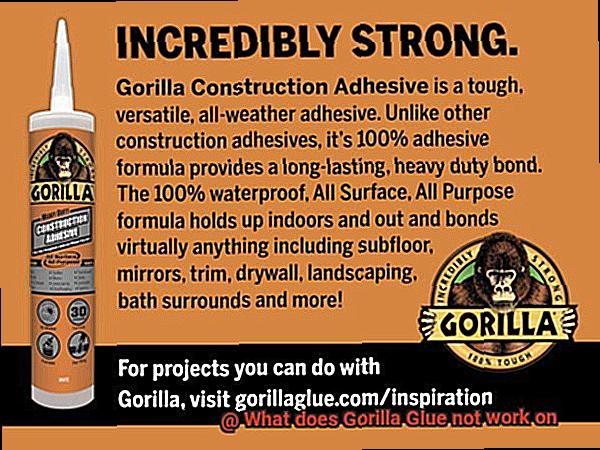
Fabrics – Repelling Love:
Synthetic fabrics like nylon and polyester, often low in porosity, can repel Gorilla Glue. It struggles to penetrate the fabric fibers and create a secure bond. With frequent bending, stretching, and washing, the adhesive bond weakens further over time, leaving your project vulnerable.
Flexible Plastics – Inert and Immune:
Polyethylene and polypropylene plastics are chemically inert and have low surface energy. These characteristics make it challenging for Gorilla Glue to create a strong bond. Combine this with their tendency to move and flex, and you have a recipe for adhesive failure that might leave you feeling stuck.
Foam – Absorbing Adhesive Woes:
Foam materials are porous structures that can absorb Gorilla Glue instead of forming a strong bond on the surface. As foam compresses and flexes, the adhesive bond weakens, leaving you with a less-than-desirable result. It’s like trying to glue air.
Extreme Heat or Direct Sunlight
Gorilla Glue, the superhero of adhesives, is celebrated for its unmatched bonding strength in DIY projects. However, even superheroes have their weaknesses, and for Gorilla Glue, extreme heat and direct sunlight prove to be formidable foes.

In this article, we will delve into the divergent effects of these conditions on Gorilla Glue’s performance, offering tips to optimize its adhesive capabilities.
The Melting Point:
Picture a scorching summer day, with temperatures skyrocketing above 100°F. While you sip on a refreshing drink, your Gorilla Glue might be succumbing to the heat. Extreme temperatures can cause the glue to melt or become pliable, compromising its ability to form a robust bond. Thus, it’s prudent to reconsider using Gorilla Glue in environments with high heat.
The Slow Fade:
Now let’s explore direct sunlight, the gradual nemesis of Gorilla Glue’s adhesive strength. Those powerful UV rays from the sun not only harm your skin but also deteriorate the glue over time. This is especially true for outdoor applications exposed to prolonged sunlight. Thus, it is vital to consider the long-term effects of sunny days when planning an outdoor project with Gorilla Glue.
Specialized Solutions:
Fear not. Gorilla Glue recognizes the challenges posed by extreme heat and direct sunlight and has developed specialized solutions. They offer High-Temperature Gorilla Glue that withstands scorching temperatures without compromising its bonding properties. So, if you anticipate working in such conditions, opt for this specialized adhesive to ensure optimal performance.
Preparation is Key:
Irrespective of the conditions, proper application and surface preparation are pivotal for Gorilla Glue’s magic to materialize. Before applying the glue, ensure that the surfaces are clean, dry, and devoid of contaminants. This guarantees a robust bond and maximizes Gorilla Glue’s effectiveness, even in challenging circumstances.
Underwater Applications
Today, we embark on an exciting journey into the realm of underwater applications. While Gorilla Glue may be your trusty sidekick for most projects, it’s time to reveal its weakness when it comes to exploring the depths beneath the waves. Join us as we dive deep into the reasons why Gorilla Glue isn’t suitable for life underwater.
The Chemical Conundrum:
Gorilla Glue’s secret weapon lies in its unique ability to expand and foam upon contact with moisture. This feature makes it perfect for filling gaps and bonding uneven surfaces above water. However, beneath the surface, this expansion and foaming action become its downfall. Submerged in water, the bond weakens, leaving you high and dry without a reliable adhesive.
Water Woes:
Imagine spending hours meticulously applying Gorilla Glue underwater, only to find that it deteriorates over time when exposed to water. It’s like watching your favorite superhero lose their powers – disappointing and ineffective. Once dried, Gorilla Glue lacks resistance to water or moisture, making it ill-suited for long-lasting bonds in aquatic environments.
The Oxygen Obstacle:
In its composition, Gorilla Glue contains polyurethane, a key ingredient that requires oxygen to cure and create a strong bond. Unfortunately, underwater environments lack sufficient oxygen, hindering the curing process and resulting in weak or non-existent bonds. Even superheroes need air to thrive.
Aqua Alternatives:
Fear not, fellow adventurers. Specialized adhesives have been formulated specifically for underwater applications. Marine-grade epoxies and silicone sealants are the true heroes of the underwater world. These remarkable adhesives withstand constant water exposure and provide reliable bonds in wet conditions. With them, your projects will remain intact even in the darkest depths of the ocean.
Conclusion:
While Gorilla Glue may be your faithful companion in many DIY projects, it falls short when it comes to underwater applications. Its expansion and foaming reaction, coupled with its need for oxygen to cure, make it unsuitable for bonding or sealing underwater. To ensure a strong and lasting bond in your underwater projects, seek out adhesives specifically formulated for this purpose. Remember, even superheroes have their limitations, and it’s crucial to choose the right adhesive for the job at hand.
Food or Beverage Contact
Safety First:
When it comes to our food and drinks, safety is of utmost importance. That’s why using adhesives like Gorilla Glue, which is not recommended for food or beverage contact surfaces, is a big no-no. These adhesives contain chemicals that could be harmful if accidentally ingested.
Complying with Regulations:
To guarantee the safety of our consumables, it is crucial to use adhesives that comply with FDA regulations. Fortunately, there are specialized food-grade adhesives available in the market designed specifically for surfaces like kitchen countertops, cutting boards, and utensils.
The Secret Ingredients:
Food-safe adhesives are formulated with non-toxic ingredients that are resistant to moisture, heat, and food acids. This ensures that they won’t contaminate your delicious meals or beverages.
Prevention is Key:
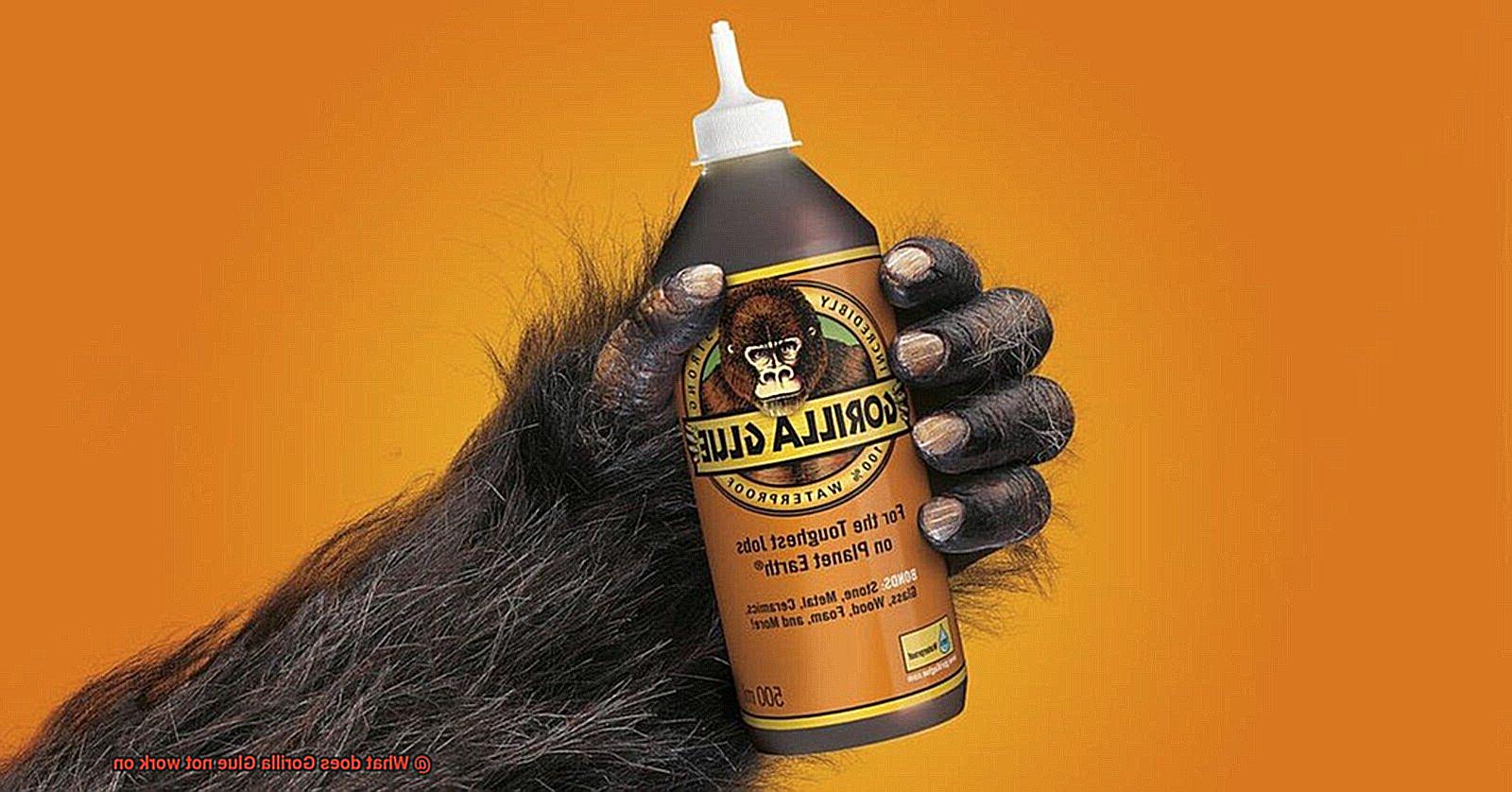
Using the wrong adhesive on food contact surfaces can potentially lead to contamination and health risks – something we definitely want to avoid. By using adhesives specifically designed for such applications, we ensure the safety of our food and beverages.
Accidents Happen:
In the unfortunate event of accidental ingestion of any adhesive, seeking immediate medical attention is advised. It’s always better to be safe than sorry.
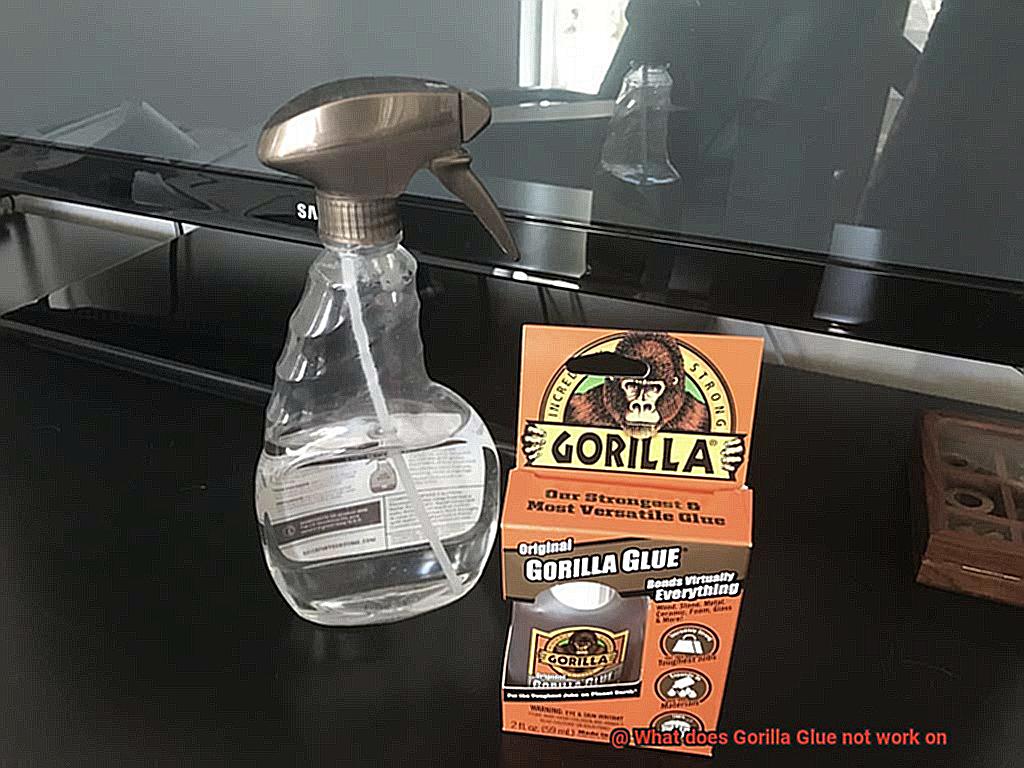
Maintenance Matters:
Remember, even with the right adhesive, proper cleaning and maintenance procedures for food contact surfaces are essential. This helps prevent the need for adhesive repairs in the first place.
Delicate Surfaces
In the world of adhesives, few are as mighty as Gorilla Glue. This powerful adhesive has earned a reputation for its exceptional strength and durability. However, when it comes to delicate surfaces, Gorilla Glue may not always be the hero we need. In this article, we will delve into the intricacies of delicate surfaces and explore why Gorilla Glue may not be the best choice. Fear not, for we shall also unveil alternative options to ensure your delicate projects are handled with care.
Glass Surfaces:
Smooth and non-porous, glass poses a unique challenge for Gorilla Glue. Its formidable grip may struggle to find purchase on this slick surface. Moreover, applying Gorilla Glue to glass can leave behind stubborn residue or unsightly marks that seem impossible to erase.
Ceramic Surfaces:
Picture this: your beloved ceramic vase has suffered a devastating crack. While Gorilla Glue may seem like the obvious solution, tread carefully. The glaze on ceramic surfaces can thwart the adhesive’s valiant efforts, resulting in weak bonds or visible blemishes. Seek out specialized adhesives tailor-made for ceramics to save the day.
Plastics:
Delicate plastics, such as polyethylene or polypropylene, require a gentle touch when it comes to adhesion. Unfortunately, Gorilla Glue may not possess the finesse needed for these low surface energy materials. Look beyond the gorilla’s domain and discover specialized plastic adhesives designed with delicate plastics in mind.
Delicate Fabrics:
The allure of silk and satin is undeniable, but their delicate nature demands a careful approach when it comes to adhesives. Gorilla Glue can infiltrate the fibers with ease, leaving behind unsightly stains or discoloration. Consider fabric-specific adhesives or explore the art of sewing as an alternative to preserve the beauty of delicate fabrics.
Papers and Cardstock:
Delicate papers and cardstock, with their fragile allure, may crumble under the might of Gorilla Glue. The moisture and expansion properties of this adhesive can lead to warping or unsightly wrinkles. Protect your paper creations by seeking out acid-free adhesives or other paper-specific glues.
OCAxSFDcrxc” >
Conclusion
Gorilla Glue, known for its strong adhesive properties, is a versatile product that can bond various materials together. However, there are certain surfaces and materials that Gorilla Glue does not adhere well to. It is important to be aware of these limitations to ensure successful application.
One thing Gorilla Glue does not work well on is polyethylene or polypropylene plastics. These types of plastics have low surface energy, making it difficult for the glue to form a strong bond. If you need to join these types of plastics, it is best to use a specialized adhesive designed specifically for this purpose.
Another material that Gorilla Glue may struggle with is smooth or glossy surfaces. The glue needs a rough or porous surface to grip onto in order to create a strong bond. If you are working with glass, metal, or other smooth surfaces, it may be necessary to roughen the surface beforehand using sandpaper or another abrasive tool.
Additionally, Gorilla Glue is not recommended for use on items that will be exposed to continuous moisture or water immersion. While the glue is water-resistant once fully cured, prolonged exposure to water can weaken the bond over time. In such cases, it is advisable to choose a waterproof adhesive specifically formulated for wet environments.
In conclusion, while Gorilla Glue is an effective adhesive for many applications, it has limitations when it comes to certain materials and conditions.

